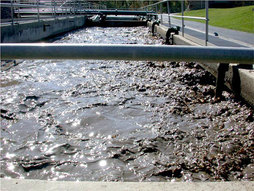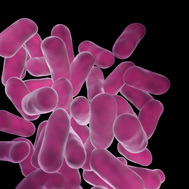- Aeration in most biological treatment units functions to both provide dissolved oxygen and to suspend or mix the solids/influent wastewater. Using a diffuser or high oxygen transfer aerator to mix wastewater takes much more energy than a single purpose mixer. So, we can save on power costs by using a true mixer in system where required mixing energy from diffusers results in DO above 3.0 mg/L
- Heterotrophic or COD/BOD removing bacteria can work at DO levels well below 2.0 mg/L. Using a synthetic wastewater with COD = 300 mg/L, biosolids residence time 10 days - the researchers ran the unit with a DO of 2.0, 0.5, and 0.1 mg/L - effluent results were all 10 - 11 mg/L COD. therefore COD removal in non toxic wastewater can be achieved using much lower than 2.0 mg/L DO.
- While heterotrophic can grow well at very low DO, engineers have said the 2.0 mg/L DO is meant to maintain autotrophic nitrifier populations that convert ammonia into nitrite/nitrate. Researchers have found the nitrosomonas (NH4 -> NO2) perform well at 0.5 mg/L DO. Assuming no inhibitory compounds. Nitrobacter (NO2 -> NO3) have lower activity at 0.5 mg/L DO - roughly 12% activity). So a DO <0.5 mg/L with no inhibition to nitrifiers may lead to increased effluent NO2. What the research has found is the amount of inlet COD and inhibitory compounds has more impact on autotrophic nitrifiers than biological unit DO. Running at DO >2.0 mg/L does not give a significantly greater level of activity.
- The greatest impact of lower DO is on biological polymer or floc format
|
Most wastewater systems I have visited target dissolved oxygen (DO) residuals in the aeration basin above 2.0 mg/L - in fact most industrial customers run at 3 - 3.5 mg/L if possible. As energy or electricity costs for aeration are a major part of the operational costs - this has led me to question the wisdom of a "one size fits all" number for dissolved oxygen. In researching this question, I have found some interesting data and I will share some of the information with you.
 Aerobic Sludge Digester Aerobic Sludge Digester Many facilities use aerobic digesters to reduce volumes and improve sludge handling characteristics of biological solids produced in the wastewater treatment system. The aerobic digester works on the same biochemical principals as the general wastewater treatment system in that microbes convert influent organics into carbon dioxide, water and new cells. Of course there are many steps and intermediates produced, but the digesting process results in a reduction in mass - as the low F/M conditions produce fewer new cells and much of the energy is used for cell maintenance rather than new cell production. Aerobic digesters with a 40 day retention time average 38 - 50% reduction in VSS compared to anaerobic digesters reducing VSS by 56 - 65% with a 30 day retention time. Just as important as solids reduction is improved dewatering/drying characteristics of the biosolids. Often organics such as grease and surfactants can create high levels of water and polysaccharides in the biosolids (floc). An efficient digester will act to continue the biological degradation of these compounds that was left incomplete in the main biological treatment unit. With the high costs of removing water, handling, and disposing of biosolids, wastewater system engineers often look for ways to enhance solids destruction in the digester. Options include adding more aeration, mixers, and often "bioadditives". In bioadditives, I am lumping in both bioaugmentation cultures (i.e. bugs) and various enzyme or micronutrient products. The big question is ... can reduced sludge volume/mass justify the expense of adding these products? While my company, Aster Bio, manufactures multiple biochemicals, I will say it all depends upon the makeup of the biosolids as to how well any product will help with the digester performance. In systems with high levels of entrained water or polysaccharides (biopolymers), the addition may very well give great results and easily justify the costs of addition. Other times, the improved dewatering properties may help reudce polymer usage or moisture in the solids which can justify the product cost. In all cases, we can screen the products using an aerated, temperature controlled lab test. This lab test should be done before committing to any full scale implementation.  In nature, bacteria compete for carbon sources (energy), macronutrients, and micronutrients. As a part of this competition various microbes engage in their own form of chemical warfare by making antimicrobial compounds that work against competing microbes. We are most familiar with these compounds as many of our common antibiotics including polymyxin and bacitracin come from common soil spore forming microbes. In addition to manufacturing antibiotic pharmaceuticals (which are highly refined compounds), the natural production of antimicrobial compounds is a key part of the science of using microbes to competitively exclude pathogenic and opportunistic pathogenic microbes. Examples of applications using microbial competitive exclusion:
One of the core pieces of data for monitoring any wastewater system is the solids mass balance. We can use the mass balance to determine sludge age (MCRT), food to microorganism ration (F/M), cell yield, and cell decay (endogenous respiration/digestion).
Aerated Basins
The missing part is the amount of solids accumulating in the bottom of the ponds. Also we are not sure of the amount of cell lysis (digestion). With good record keeping, and knowledge of the cell lysis rates, it is possible to get a true estimate of cell yield and pond sludge accumulation. Activated Sludge A solids mass balance is much more important in activated sludge treatment systems. All the data is usually collected on a frequent basis, but sometimes it is not put into a spreadsheet model for use in monitoring/auditing the system. We need solids concentration and flow for the following:
While we often calculate sludge age or food/microorganism (F/M) ratios from this data, we can also get an idea for cell yield and amount of in basin endogenous respiration. This can be later evaluated when doing aeration cost evaluations. |
AuthorErik Rumbaugh has been involved in biological waste treatment for over 20 years. He has worked with industrial and municipal wastewater facilities to ensure optimal performance of their treatment systems. He is a founder of Aster Bio (www.asterbio.com) specializing in biological waste treatment. Click to set custom HTML
Archives
April 2024
|

 RSS Feed
RSS Feed